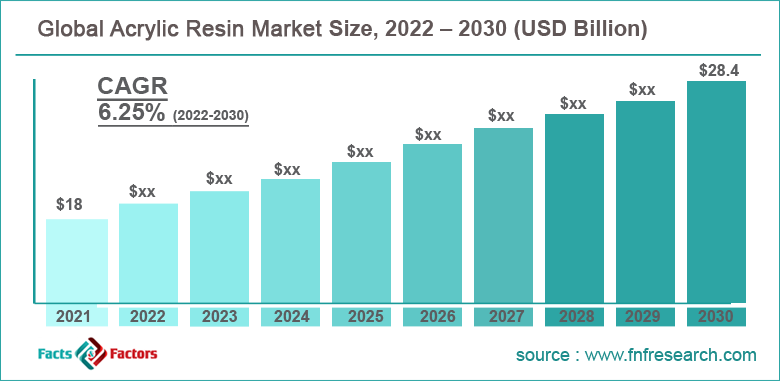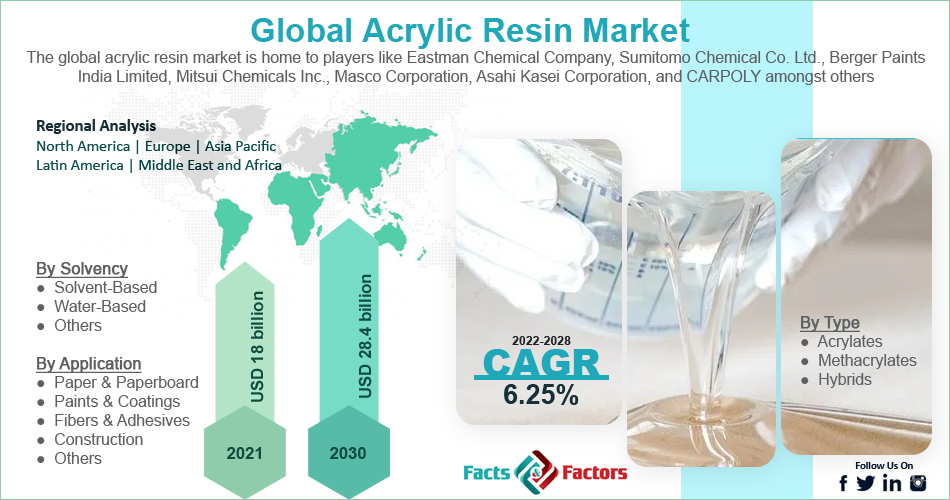Search Market Research Report
Acrylic Resin Market Size, Share Global Analysis Report, 2022 – 2030

Acrylic Resin Market Size, Share, Growth Analysis Report By Solvency (Solvent-Based, Water-Based, and Others), By Type (Acrylates, Methacrylates, and Hybrids), By Application (Paper & Paperboard, Paints & Coatings, Fibers & Adhesives, Construction, and Others), and By Region - Global and Regional Industry Insights, Overview, Comprehensive Analysis, Trends, Statistical Research, Market Intelligence, Historical Data and Forecast 2022 – 2030
Industry Insights
[208+ Pages Report] According to the report published by Facts Factors, the global acrylic resin market size was worth around USD 18 billion in 2021 and is predicted to grow to around USD 28.4 billion by 2030 with a compound annual growth rate (CAGR) of roughly 6.25% between 2022 and 2030. The report analyzes the global acrylic resin market drivers, restraints/challenges, and the effect they have on the demands during the projection period. In addition, the report explores emerging opportunities in the acrylic resin market.
 Market Overview
Market Overview
Acrylic resin contains acrylic monomers and exists in the form of a polymeric solution which can be a solution, solid, or in the form of a dispersion. The monomers used for the production of acrylic acid are generally esters of methacrylic acids, acrylic, or their derivatives. Acrylic resin can be used for different functions by introducing various chemical groups, also known as R groups in the structure. The application of acrylic resin varies depending on industry and currently, they are widely used in the coatings and paints industry with solvent-based or water-based forms depending on the industrial end goal.

Acrylic resins are known to exhibit a considerably good range of photochemical and chemical resistance, making them desirable in the end-user verticals. Different factors like the average molecular weight of the polymers, glass transition temperature, and polymer molecular weight distribution defines the dispersion and viscosity of the resin which in turn is responsible for determining the flexibility or harness obtained in the final coating or film. Acrylic resins can be broadly classified into two types, depending on the composition. The first type is called the pure type since they are made of only acrylic monomers. Complex acrylic resins are created to meet specific properties by using different types of monomers along with acrylic polymers.
 Key Insights
Key Insights
- As per the analysis shared by our research analyst, the global acrylic resin market is estimated to grow annually at a CAGR of around 6.25% over the forecast period (2022-2030)
- In terms of revenue, the global acrylic resin market size was valued at around USD 18 billion in 2021 and is projected to reach USD 28.4 billion, by 2030.
- The market is projected to grow at a significant rate due to the increasing shift toward water-based acrylic resin
- Based on solvency segmentation, water-based was predicted to show maximum market share in the year 2021
- Based on application segmentation, paints & coatings was the leading application in 2021
- On the basis of region, Asia-Pacific was the leading revenue generator in 2021

 Growth Drivers
Growth Drivers
- Increasing shift toward water-based acrylic resin to propel market demand
The global acrylic resin market is projected to grow owing to the rising shift of preference toward resin derived from water-based acrylic polymers which are known to be more eco-friendly as compared to solvent-based acrylic resin. Certain solids or liquids emit volatile organic compounds (VOCs) in the form of gas. VOCs have low water solubility and high vapor pressure. VOCs are chemicals made in factories and used extensively in the production of pharmaceutical products, refrigerants, paints, and coatings. As indicated by studies, VOCs are extremely harmful to human health and constant or prolonged exposure can lead to multiple medical issues.
Some of the conditions observed in people who are regularly exposed to VOCs include irritation in the nose, eyes, and throat, loss of coordination, constant headache, and damage to the kidney or liver. It can also impact the central nervous system (CNS). Some studies have concluded that certain VOCs are carcinogenic and currently some of them are suspected carcinogens. Solvent-based acrylic resin emits VOCs in large quantities making them unsuitable for sustainable growth. This is leading to more end-consumers and businesses shifting to water-based acrylic resin as they are known to emit fewer hydrocarbons and also aid the reduction of the dispersion effect, which means that the amount of VOCs emitted is considerably low.
 Restraint
Restraint
- Strongest government rules surrounding acrylic resin to restrict market expansion
The paint and coatings industry, one of the largest consumers of acrylic resin, is generally highly regulated in regional economies. This is due to the high level of chemical concentrates present in the products which are harmful to the ecology as well as the health of the living organisms. The frameworks around the use of acrylic acid are stringent and vary from one region to another. Market players have to be adept in updating their production or marketing lines depending on these regulations to meet the set standard. This acts as a major growth restraining factor.
 Opportunities
Opportunities
- Better chemical properties as compared to alkyd resin to provide growth opportunities
Alkyd resins are the main substitutes for acrylic resin. However, they are known to have lesser-grade physical and chemical properties as compared to acrylic resin making the latter more desirable in the market. Acrylic resins have shown high resistance to water and chemical-induced change. They also have desirable mechanical properties leading to higher preference in the global market. The growing number of architectural activities requiring color change could lead to higher growth in the market.
 Challenges
Challenges
- Presence of toxins in acrylic paints to act as a major challenge
Studies have shown that acrylic paints contain certain levels of toxins embedded in the pigmentation just like in the case of certain oil paints. Acrylic paints that make use of retarder that allow the slowing down of drying time can lead to the addition of higher toxins making them hazardous in case of direct exposure and for the people constantly surrounded by acrylic paints like workers in paint and coating factories or the people involved in applying the coatings on surfaces.
 Segmentation Analysis
Segmentation Analysis
The global acrylic resin market is segmented based on solvency, type, application, and region
Based on solvency, the global market divisions are solvent-based, water-based, and others. In 2021, the global market registered high growth in the water-based segment, and the same trend is projected to be seen in the coming year owing to the environment-friendliness of the water-based solvency. The counterparts are expensive and contain high levels of VOCs. As per studies, solvent-based thinners, paints, or brush cleaners contain up to 50% VOCs. However, solvent-based acrylic resins are more suited for exterior painting and water-based is desirable for projects related to home interiors.
Based on application, the global market divisions are paper & paperboard, paints & coating, fiber & adhesives, construction, and others. The highest growth was registered in 2021 in the paints & coatings segment due to the higher applications of the compound in the sector. Acrylic resins are a part of the basic ingredients required to produce paints. Sherwin-Williams, one of the largest paint suppliers, generated USD 18 billion in revenue in 2019.
 Recent Developments:
Recent Developments:
- In October 2022, Golden Artist Colors, a US-based paint company, announced the release of 37 new colors. The new products add to the company’s already existing line of High Flow Acrylics
- In April 2022, Synthos, a European chemical company, launched its first bio-based acrylic dispersion called Synexil AW90CX. 45% of the raw materials used are derived from renewable sources of energy
 Report Scope
Report Scope
Report Attribute |
Details |
Market Size in 2021 |
USD 18 Billion |
Projected Market Size in 2030 |
USD 28.4 Billion |
CAGR Growth Rate |
6.25% CAGR |
Base Year |
2021 |
Forecast Years |
2022-2030 |
Key Market Players |
Eastman Chemical Company, Sumitomo Chemical Co. Ltd., Berger Paints India Limited, Mitsui Chemicals Inc., Masco Corporation, Asahi Kasei Corporation, CARPOLY, and others. |
Key Segment |
By Solvency, Type, Application, and Region |
Major Regions Covered |
North America, Europe, Asia Pacific, Latin America, and the Middle East &, Africa |
Purchase Options |
Request customized purchase options to meet your research needs. Explore purchase options |
 Regional Analysis
Regional Analysis
- Asia-Pacific to lead with the highest market share
The global acrylic resin market is projected to witness the highest growth in Asia-Pacific during the projection period owing to the growing demand for protective paints and coatings in the expanding economies of China, India, Japan, Singapore, and South Korea. China currently leads the global chemical industry due to the presence of the largest chemical manufacturing plants and facilities producing million of tons of chemicals annually and exporting them to other countries while also using the products for in-house infrastructure development. The country has also registered a high influx of foreign investments in the chemical production sector. Growth in Europe could be driven by the growing investments and research & development for innovating eco-friendly paints, varnishes, or coatings following the growing efforts toward sustainable development. The Middle East is projected to become a lucrative market for growth in the future.
 Competitive Analysis
Competitive Analysis
- Eastman Chemical Company
- Sumitomo Chemical Co. Ltd.
- Berger Paints India Limited
- Mitsui Chemicals Inc.
- Masco Corporation
- Asahi Kasei Corporation
- CARPOLY
The global acrylic resin market is segmented as follows:
 By Solvency Segment Analysis
By Solvency Segment Analysis
- Solvent-Based
- Water-Based
- Others
 By Type Segment Analysis
By Type Segment Analysis
- Acrylates
- Methacrylates
- Hybrids
 By Application Segment Analysis
By Application Segment Analysis
- Paper & Paperboard
- Paints & Coatings
- Fibers & Adhesives
- Construction
- Others
 By Regional Segment Analysis
By Regional Segment Analysis
- North America
- The U.S.
- Canada
- Mexico
- Europe
- France
- The UK
- Spain
- Germany
- Italy
- Nordic Countries
- Denmark
- Sweden
- Norway
- Benelux Union
- Belgium
- The Netherlands
- Luxembourg
- Rest of Europe
- Asia Pacific
- China
- Japan
- India
- Australia
- South Korea
- Southeast Asia
- Indonesia
- Thailand
- Malaysia
- Singapore
- Rest of Southeast Asia
- Rest of Asia Pacific
- The Middle East & Africa
- Saudi Arabia
- UAE
- Egypt
- South Africa
- Rest of the Middle East & Africa
- Latin America
- Brazil
- Argentina
- Rest of Latin America
Industry Major Market Players
- Eastman Chemical Company
- Sumitomo Chemical Co. Ltd.
- Berger Paints India Limited
- Mitsui Chemicals Inc.
- Masco Corporation
- Asahi Kasei Corporation
- CARPOLY
Frequently Asked Questions

Copyright © 2025 - 2026, All Rights Reserved, Facts and Factors


